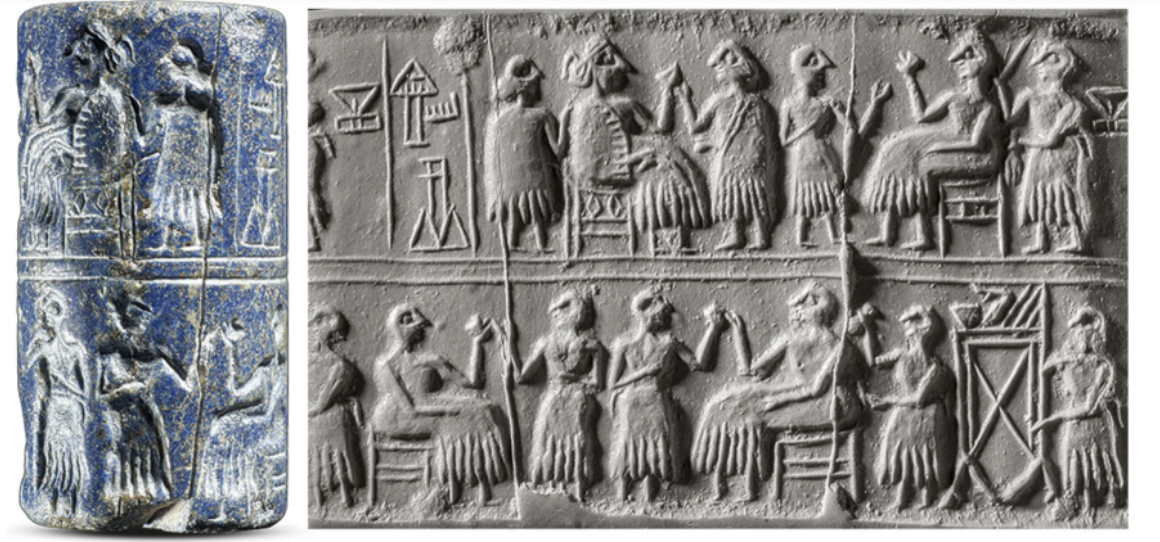[Op-Ed] Up Close with Queen Puabi's Seal: Once a Rare Privilege
MORE IN THIS SECTION

Queen Puabi's Cylinder Seal and modern impression, Mesopotamia, Sumerian, Ur. Image from the British Museum via The Morgan Library & Museum
As commoners in ancient Mesopotamia, we likely would have never had the chance to see Queen Puabi's cylinder seal up close. Yet, 4,600 years later, we can view it at the British Museum or quickly look it up on our phones. Reserved for the elite and buried with the queen herself, this artifact was an exclusive emblem of her power and status. The seal, dating back to the Early Dynastic IIIA Sumerian period, is not merely a decorative object but a profound symbol of Queen Puabi's regal authority and the societal structure of ancient Mesopotamia.
This dark blue lapis lazuli cylinder seal was discovered leaning against Queen Puabi's right upper arm, adding a layer of personal significance to the artifact. The seal’s placement suggests it was a significant and cherished item, possibly selected by her or her loved ones for inclusion in her final resting place. Along with a few other treasured objects, this cylinder seal was chosen to accompany her in the afterlife, reflecting its importance as both a symbol of her authority and a personal artifact. It showcases a detailed banquet scene with only female figures. In the upper register, two women are depicted sitting on identical folding stools, raising their drinking cups, while two servants stand between them, gesturing with raised hands, and a third servant waves a fan. The lower register portrays another female participant at a high table with a variety of foods, flanked by servants and a woman holding a jar and cup, possibly offering a drink. Additionally, a separate scene captures a musical performance with one woman playing an instrument and two others clapping cymbals.
The use of lapis lazuli in the seal, a rare and highly valued stone imported from the Badakhshan region in modern-day Afghanistan, underscores Queen Puabi’s immense wealth and the extensive trade networks of the time. The material’s rarity and the craftsmanship involved highlight the seal’s prestige and the sophisticated artistry of ancient Mesopotamia.
RELATED CONTENT
The inscription on the seal, once thought to read "Shub-ad" in Sumerian, is now recognized as "Pu-abi" in Akkadian, affirming the queen’s identity. This straightforward inscription, naming her simply as "queen," reflects her independent status and significance, contrasting with the typical practice of identifying women through their male relatives.
I had the privilege of seeing Queen Puabi's seal during the "She Who Wrote: Enheduanna and Women of Mesopotamia" exhibition last year in NYC, where I learned from Sidney Babcock that this seal stands out as one of the rare banquet scenes from Ur that includes inscriptions. The exhibition highlighted not only the artifact's historical significance but also its unique place among Mesopotamian artifacts depicting social and ceremonial life.
In Queen Puabi's time, it is uncertain whether common people of no royal status could have seen this seal up close. At most, they might have encountered its impression, not the seal itself. Yet today, we have the extraordinary privilege of examining this artifact directly, something that would have been unimaginable during Puabi's reign. This opportunity to observe the seal up close allows us to connect with a piece of history in a way that transcends time, providing a tangible link to the past that few in her own era could have experienced.
As we reflect on Queen Puabi’s cylinder seal, we are reminded that such artifacts outlive their creators and become our responsibility to preserve. Puabi’s seal is not just a relic but a testament to the enduring impact of art and identity, highlighting that we are merely the holders of these objects, and perhaps they even own us in their own way





LEAVE A COMMENT: